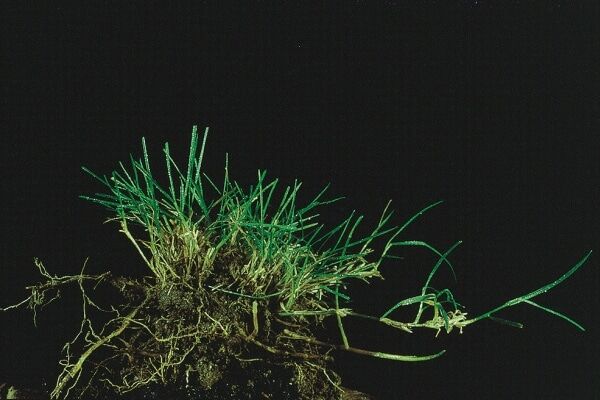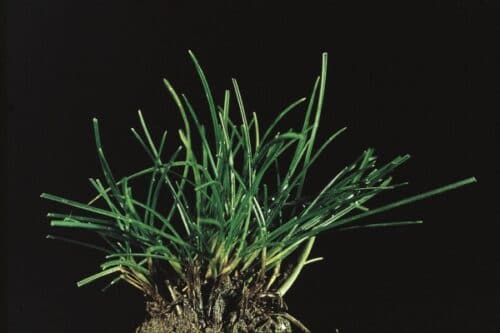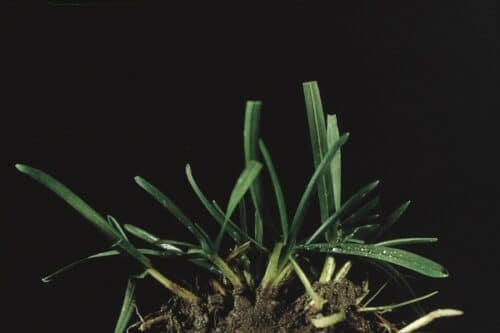
Home ▸ Lawn Care Guide ▸ How to repair a lawn ▸ What grass should I use for my lawn?
What grass should I use for my lawn?
Knowing what grass type makes up your lawn can be essential in tailoring your maintenance plan or when creating a new lawn, as different species will have distinct requirements in terms of how much moisture, nutrients and mowing is needed. Most lawns will contain a mixture of species, but if you are considering reseeding or turfing a lawn from scratch, you should make sure you choose the appropriate variety for your garden.
The first thing to do before considering a grass seed or turf variety is to look closely at your individual garden environment and decide what is likely to grow successfully in your location. Three major factors are your soil type, how much sunlight the lawn will get and how well the soil drains. It is also important to choose a variety of grass that will be fit for purpose, depending on the use, wear, and the maintenance regime it is likely to receive.
What’s the best grass type for my lawn?
If you are considering reseeding a lawn from scratch, it is a great opportunity to introduce different grass varieties to help tackle the challenges of your lawn. See our recommendations below:
For light sandy or chalky soil
Strong, slender or chewing fescue does well in sandy soils and free draining sites, but you can include some dwarf ryegrass in the mix too. This makes it harder wearing, darker green and it will compensate for the fescue’s slower growth. Introduction of smooth stalked meadow grass (Poa Pratensis) can also assist with drought tolerance and recovery from wear and tear.
For heavy, clay soils
Given clay soil’s tendency to become compacted and retain moisture, it’s best to choose a seed mix including ryegrass for its general hardiness, and tall fescue, which has a deep root system. This ensures the roots are deep enough that they don’t get drowned if there are periods of sustained wet weather affecting the top few inches of the lawn.
For heavy use lawns
If your garden is heavily used by children and pets, you want to include harder wearing, durable grasses to withstand the wear and tear. You’ll want a seed mix that is predominantly rye grass, this is why most heavy duty sports pitches contain this type of grass, but choosing a mix including creeping fescue can help ensure a dense sward while encouraging any bare areas to fill in quickly.
Ornamental lawns
For the lawn enthusiast who doesn’t mind a more hands-on maintenance regime, a seed mix of fine fescues with a high volume of bent grass will give you a fine, lush carpet of a lawn if maintained correctly. You will need to include scarification and aeration in your maintenance schedule, and weeds can try and invade, so do keep on top of those.

Ryegrass
Dwarf ryegrass is one of the most common species in UK lawns, as its properties are suitable for our four-season climate. It used to be coarser and regarded as an agricultural grass but in recent years much finer-leafed varieties have been bred which have become a staple for modern lawns and fine sports turf. It can be identified by the red-purple colouration at the very base of the grass plant and a flat leaf.
Advantages
- Great drought tolerance
- Very easy to maintain
- Can thrive in both cold winters and hot summers
- Good wear resistance
- Fast growing
- Dark green colour
Disadvantages
- Very few disadvantages, apart from more frequent mowing needed in peak growth periods due to its rapidly growing nature

Common or ‘browntop’ bent
This grass has an even finer appearance so is often chosen for bowling greens, golf greens and high quality ornamental lawns. It also has creeping underground roots so can form a dense, thick sward but does require more maintenance with mowing and watering to keep it at its best. Mowing regularly with a cylinder mower is recommended, along with occasional verti-cutting.
Advantages
- Very fine finish achievable
- Thick, dense coverage can be achieved
- Perfect to mix with fescue for fine lawns
- Ideal for fine sports turf
Disadvantages
- High maintenance in terms of watering and mowing
- More susceptible to disease
- Requires scarification and verti-cutting to keep it at its best
- Requires mowing with a cylinder mower for best results

Fescue
Fescues are finer-leafed varieties of grasses and as such can require a bit more TLC. They can be slower growing and quite delicate so are often used in a mix with other more hardwearing grasses, so the lawn still has a fine appearance but is more resilient. They do well in shady areas and can establish well even in difficult soil conditions because they produce Rhizomes to reproduce and spread.
- Tall fescue is one of the coarser fescues and has a deep root system making it particularly drought tolerant.
- Red fescue/ Chewing fescue is one variety that is both shade and drought tolerant but can be slower to grow. It does well even in sandy or acidic soils.
- Slender Creeping Red fescue, like the name suggests, is a finer leafed variety of red fescue, with similar properties and increased drought tolerance due to its ‘creeping’ roots, which also enable it to fill in bare areas quickly. It can tolerate lower mowing heights so is sometimes used in bowling greens or golf courses.
Advantages
- Tolerates both hot and cold weather well
- Upright growth creates nice even-looking grass
- High drought tolerance
- Fine appearance for top quality lawns
Disadvantages
- Not as wear resistant
- Does not recover well from severe injury
- Requires additional maintenance such as scarification to reduce thatch build-up

Smooth Stalked Meadow Grass
Smooth Stalked Meadow Grass (Poa Pratensis) has become a firm favourite with turf producers due to its super-strong strength and durability. You should not be put off by the name, meadow grass, which confuses a lot of people when buying lawn seed or turf. SSMG has been produced by breeders for its resilience to wear and tear and good colour. The root system produces Rhizomes which spread throughout the sward and are very efficient in dry weather.
SSMG is usually blended with Fescue and/or dwarf rye to create an attractive hard wearing lawn or turf and is widely used by golf courses on golf tee’s. When sowing it is vital to ensure it is sown to a depth of 2cm, ideally in the summer or autumn when the soil is warm. If you are trying to establish an eco-friendly lawn SSMG mixes well with micro-clover to create a self sufficient lawn which will require little nutrient or chemical input.
This grass has an even finer appearance so is often chosen for bowling greens or golf greens. It also has creeping underground roots so can form a dense, thick sward but does require more maintenance with mowing and watering to keep it at its best.
Advantages
- Hard wearing
- Attractive
- Fast recovery from damage
- Strong root system
- Ideal for drought resistance
Disadvantages
- Harder to establish due to sowing depth
- Slow to establish
- Lighter shade of green which is sometimes noticeable at certain times of the year
